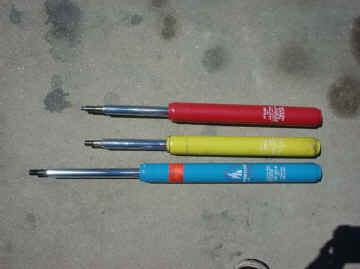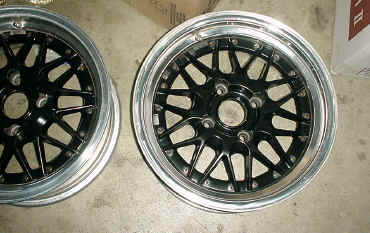Moto's LEVIN...
Performance as AE86 was meant to have?
Sort of...
by Moto-P
![]()
So this is January 2001, the new millennium and appropriately, I'm thinking, for the usable life of my new AE86... In the past articles, I have concentrated on describing you the equipment list and the construction process of the AE86. Now we put it to use. I would like to use the following articles to guide you in my own personal goals and the direction of the AE86 as I have come to covet. So here we go...
The reason for the 20V naturally aspirated engine choice was because of all the engines I have used, I felt that the normally aspirated engine fit the character of the AE86 very well and the 20V gave it just enough power update to run with current batch of cars today. You may argue that the 4A-GZE or full tuned 16V or custom turbo setups are way more powerful. But I have come to a conclusion that the reliability and capacity to run extended sport drive is most important in a car that has to run in many track events as well as various stages of autocross. The naturally aspirated engine gives great response to let you handle tricky situations with a bigger margin. Big handling margin with a predictable engine means more consistency in driving. The less mistake the better chance you have for racing in extended run.
I had a chance to chassis dyno my engine running the setup as described in the previous articles. The following scan shows the preliminary results taken last month.
As you can see, the engine produced slightly less than 160 peak horsepower, 159.0. You may say this is not an impressive figure but if you consider how flat the curve, you will begin to see that the engine is a very predictable. In second gear, the power output is very constant from 140km to 200km/h, or from about 5500rpm to the 9000rpm where the rev limit hits.
This absolute predictability in power output combined with linear and precise response given by the individual throttle and VVT makes a very nice motor indeed to have in the AE86, where the driver wishes to control the attitude and the balance in a dynamic sense. Mid-drift, mid-corner inputs are easy and the driver can adjust to changes in road, speed, and most importantly correct mistakes.
After getting a comfortable figure from my engine, I locked up the memory bank #2 of the Freedom ECU to go testing at the track. The bank #1 contains my street driving MAP for efficiency and clean air, it contains a fuel and timing map utilizing the air/fuel learning mode fed by O2 sensor and Vacuum and about 6 other variables to come away with smooth reliable power with a preset 8000rpm red (which I'm free to adjust later). Bank 2 contains a completely separate map for racing use which I had programmed and fine tuned for max power delivery and safety at top end...needless to say, this is where my 9000rpm redline mode is... The number 2 map also utilizes the throttle speed mode, and works much like a carburetor where throttle opening chiefly determines the fuel delivery map. The vacuum sensor is left to only the task of making the fuel system stable only in dangerous lean temperatures. The throttle speed mode gives maximum response to throttle as the injectors need not wait for the changes in vacuum pressures. More on this later... but Freedom ECU actually has room for 2 more separate maps which you can program for different purpose. You can change between them with a dial switch located on the side of the ECU unit. This way you can play with any parameters without the risk of getting stranded if you really mess things up... It's just a flick of a switch to get it back to a different running map program.
In the 3 months that I had the car so far, I have run 2 track events, 3 autocrosses and the result was bullet proof reliability and performance. On the way to the first track event at Buttonwillow Raceway, requiring going over a 5000ft mountain pass, the engine started to hick-up...and lost all power through range of revs...but within 5 minutes into the climb, the self-learning ECU feature quickly made adjustments to the newly presented altitude and atmospheric condition and gave me a clean map up to 85% throttle where I had programmed for it to correct. If I had set the ECU to do full 100% throttle, the ECU would have done that too. But I had concern to not screw with the full throttle figure so I won't alter the max pedal performance the day's event... In retrospect, I should have let it...as I found out the ECU was smart enough to cope with that capacity... Naturally, on the way back, I set it to 100% for full 5000ft altitude compatibility, and boy it was amazing as it finished up it's learning.
At the track, the ECU learned more and more to produce the power. By 20 minutes into the ECU learning mode, racing around, the throttle became more and more responsive and the ECU never sent the mixture overly lean while it did it's own experimentations. When I saw no more changes taking place in the mixture, I locked the ECU from leaning to fixed map mode.
In the chassis side, my initial setup of 7kg spring front, 5.1kg rear with Illumina short stroke front and Koni adjustable rear worked well. With shorter stroke front shocks, the front had not bottomed out as before with slicks mounted on all four. The Koni initially proved to be too stiff in rebound rating, as it prevented the car from pitching forward enough to give neutral balance. So, the Koni was adjusted to a much softer rating and it gave it much better constant G cornering balance. The Koni also proved to give much better traction levels and though drifting the car became more hairy, the acceleration out of the hole was just what I needed to keep up and out pace the Honda Civic out of corners, just like in the Volume 41 BM Video with TRD AE86 vs. Civic R. Needless to say, the Type R still caught me in the straight to join me into the next corner... If the event allowed passing in the corners, the outcome would have been dangerously close but really interesting for the spectators. I'm still waiting for Tokico's new series, the HTS102 especially made for AE86...

Tokico HTS102 Front Shocks in red, Yellow TRD AE92, Blue Tokico HP in standard AE86 length.
Hey you guys can do me a favor by calling Tokico yourself to bug them to introduce them here in the USA as I hear it's the new standard in AE86 shocks... 40mm shorter stroke on all four wheels for that lower stance without clearance problems, maximum adjustability for use from 2.5 to 20kg springs, its all-in-one solution to race/street AE86 as most of us use these days. It's also adjustable fro rebound and compression unlike the Illumina. Dream come true! No? It's like they have watched the AE86 market globally and came up with a killer solution.

my Dori2 Mesh in Black, a new acquisition...not as light as I hoped it would be but makes a nice complement to a white car... in 15x7 and 15x7.5. I use the Dori2 for street now and use the lighter Panasport 15x7 for track use with slicks.
To this date, I still have yet to learn the new car's characteristics at the very limit as well as come up with a all out track setting data for my AE86. I am learning to drive this peaky, faster AE86 day by day. So there's more to come...
Go to Part 5...If you really are bored today...